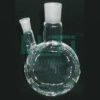- Made from ASTM E-438 Type 1, Boro 3.3 heat resistance glass
- Complies with DIN 12394 & USP standard
- Available with two neck angular
| PART No. | Capacity (ml) | Socket Size | Side Socket | Overall Height | PACK Qty. |
| 5610-50 | 50 | 24/29 | 14/23 | 90 | 1 |
| 5610-50-A | 50 | 29/32 | 14/23 | 90 | 1 |
| 5610-100 | 100 | 24/29 | 14/23 | 105 | 1 |
| 5610-100-A | 100 | 24/29 | 19/26 | 105 | 1 |
| 5610-100-B | 100 | 29/32 | 14/23 | 105 | 1 |
| 5610-250 | 250 | 24/29 | 14/23 | 140 | 1 |
| 5610-250-A | 250 | 24/29 | 19/26 | 140 | 1 |
| 5610-250-B | 250 | 29/32 | 14/23 | 140 | 1 |
| 5610-500 | 500 | 24/29 | 14/23 | 163 | 1 |
| 5610-500-A | 500 | 24/29 | 19/26 | 163 | 1 |
| 5610-500-B | 500 | 29/32 | 14/23 | 163 | 1 |
| 5610-1000 | 1000 | 24/29 | 14/23 | 200 | 1 |
| 5610-1000-A | 1000 | 24/29 | 19/26 | 200 | 1 |
| 5610-1000-B | 1000 | 29/32 | 14/23 | 200 | 1 |
| 5610-2000 | 2000 | 24/29 | 19/26 | 240 | 1 |
| 5610-2000-A | 2000 | 34/35 | 19/26 | 260 | 1 |
| 5610-3000 | 3000 | 34/35 | 19/26 | 260 | 1 |
| 5610-3000-A | 3000 | 34/35 | 24/29 | 260 | 1 |
| 5610-5000 | 5000 | 34/35 | 19/26 | 305 | 1 |
| 5610-5000-A | 5000 | 34/35 | 24/29 | 305 | 1 |
| 5610-10000 | 10000 | 34/35 | 24/29 | 380 | 1 |
| 5610-10000-A | 10000 | 55/44 | 24/29 | 380 | 1 |
| 5610-20000 | 20000 | 55/44 | 24/29 | 435 | 1 |
Here are some common uses for a 2-Neck Angular Round Bottom Flask in a laboratory:
- Parallel Reactions: The two necks allow for the setup of parallel reactions, enabling researchers to conduct multiple reactions simultaneously.
- Distillation and Fractionation: The flask is suitable for distillation setups where different components of a mixture can be collected through the two necks. This is useful for fractionation processes.
- Refluxing: The flask is suitable for reflux setups where one neck can be used for the condenser while the other allows for the addition of reagents or other equipment.
- Simultaneous Sampling: The two necks allow for the simultaneous sampling of reaction mixtures or the introduction of different materials at distinct stages of the experiment.
- Temperature Control Experiments: One neck can be used for inserting a thermometer or temperature probe, allowing for precise temperature control during reactions.
- Gas Inlet/Outlet: One neck can be used as a gas inlet, and the other as a gas outlet, facilitating reactions that involve gaseous reactants or by-products.
- Complex Reaction Setups: The versatility of a 2-neck flask allows for the creation of complex experimental setups involving various reaction components and monitoring devices.
- Parallel Distillation: Similar to parallel reactions, the flask can be used for parallel distillation, allowing researchers to simultaneously distill multiple samples.







